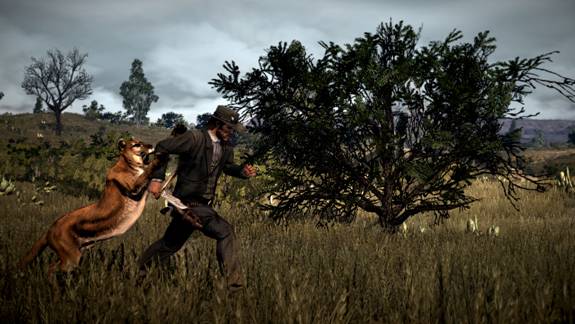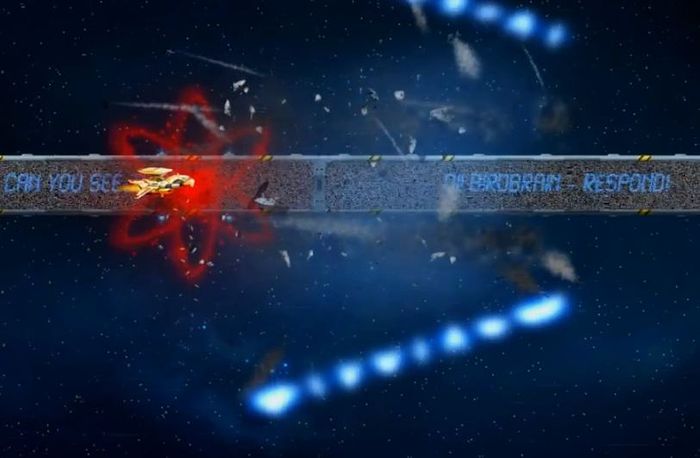
Featured Blog | This community-written post highlights the best of what the game industry has to offer. Read more like it on the Game Developer Blogs or learn how to Submit Your Own Blog Post
Writing For A Genre That Doesn't Welcome Words
Upon attempting to pen a story for a shmup and research the techniques of doing so, a question was found: Why aren't we investing more time in game narratives? It's time to really explore this relatively unknown part of game development.

[Upon attempting to pen a story for a shmup and research the techniques of doing so, a question was found: Why aren't we investing more time in game narratives? It's time to really explore this relatively unknown part of game development.]
If the gift was bestowed upon me perhaps these thoughts would be manifested in a more interactive experience, i.e. a computer game. Alas, my primary means of expression is realised by punching lettered buttons upon a keyboard so as to form syntactically correct word orderings. Call this a lazy effort then. "Get out there and make a bloody game!" you might strike out at me. "All of the resources and know-how is out there on the internet these days. It's not hard." Trust me, I know but for the purpose of this I'll rely on something I know that I can have more impact with.
Do question my reasoning here though - I'm writing a story for a game and I have no development experience whatsoever. What I do have is years of writing short stories and essays behind me. Can this be translated into a game though? Only recently have these concerns wormed their way under my skull and festered. Game writing emerged in my thoughts when I was approached by Eugeny at Sumom Games, for whom I was helping translate pidgin English, to conjure up a narrative and back story for their game Humans Must Answer. For those who don't know, Humans Must Answer is a shmup. In other words, a genre that is quite adverse to the delights of narrative-driven play. Action is the usual draw here and not character engagement, plot twists or narrative arcs.
Naturally, I questioned what they wanted out of a narrative woven into the game. From my experience, it was affirmed that a storyline in a shmup was simply bad news. Yet, they were insistent with their request and gave me the freedom to work from what they had as a basis. That being the words "2D scrolling space shooter", "distant future", "puzzle elements" and the following pidgin-English sentence:
"It's an incredible satirical adventure of two young spaceship pilots searching for knowledge and found themselves in the Solar System."
The challenge was something that had appeal. Though, it did occur to me that what they had written down could already be sufficient. The simpler the narrative is, the less invasive it would be within the final game, hopefully. And that was something we all agreed on from the very start - at no point should telling the story interfere with the natural flow provided by the game's explosive gameplay. So where do you start?
The Role of A Game Writer
In many minds, games have always been dictated first and foremost by gameplay. Do I really have to mention the continual debate around ludolody vs. narratology? I do actually as it's one I sided on a while ago; agreeing with the ludologists who fought for a unique way of understanding games through their unique adherence to the act of playing. This, to me, is what games are all about: playing. In discovering this, I find I have a problem with the term "gameplay" as it seems to have a limiting effect on a designer's creative mind. Even while I write this I notice that newly formed development studio, The Astronauts, write on this subject and provide a perfect example of what I mean.
The most memorable part of RDR was your first animal skinning. Or dragging lassoed innocents around in the dust.
In their post they discuss the idea of killing gameplay and while I agree with the notion I find a fault in their understanding and methods. "If we understand gameplay", they write, "as something that a challenge is a crucial part of" and that's where I have to stop them. Why is it that "gameplay" has to invoke a challenge? Indeed, that is their overarching point and why they've apparently decided to head out to "kill" gameplay as if it were a problem. My issue with this stems from my understanding that "gameplay" is a portmanteau of "game" and "play". At some point, we've collectively decided that the word adheres only to the meaning of the first syllable, it would seem. A "game" is typically recognised by its framing from the established rules, which inform the challenge and how to accomplish the goal. "Play" is something that game designers have only really started to purposely explore and to great effect. The act of playing is understood to be a recreational activity that's only purpose is to achieve enjoyment. It is these two parent components that should birth our concept of 'gameplay'. Recognising the potential of experimenting with the latter part of the word, rather than killing the entire thing off, should be the aim here. It's a small qualm to have but I think understanding what gameplay refers to or can be is important. That's not to imply that 'play' can be engineered either, because it can't; how can you predict a single player's imagination or what they may find recreational pleasure in, though multiple ones? Nor do I intend to incite anyone to attempt to manufacture the organic nature of play. Merely it's a recognition that more games are being developed and released that purposely allow more room for this oft unrecognised element of game design.
The point being made is that having a specific narrative can and often does introduce the rules and restraints of a 'game'. It could be argued that having a story in your game is to be at odds with the idea of play. Perhaps we can transform this into a form of play by allowing the player to have some agency in the narrative? The most extreme pursuit of this would be including the ability for them to escape it entirely if they wish. Perhaps what more game writers should strive to do, then, is to provide the tools of play rather than to introduce the constricting parameters of a narrative. Game writing has mostly been recognised in the past when it conforms to literary practices. The God of War series and To The Moon are two prominent examples of recognised and awarded game writing. While both may be deserving of their exposure, they fall into such a narrow part of game writing and that only goes to prove how little we understand about this aspect of making games. Due to this, it seems necessary to call out for more discussions on game narrative so as to open up our understanding of it and unlock its greater potential. It's often a deserving victim to complaints about shallowness due to living up to stereotypes and being void of originality, so talking about it more just has to help!
Don't get me wrong, I am not trying to negate the linear form game narratives often take, merely I propose to explore what else we can do with it. Arguably, writing for a game falls under game design. In fact, the two have always been directly connected as most narratives are conjured up by the multiple hat wearing game designers themselves. It's partly this that has undoubtedly led to the poor stories and characters we see across many games from the past and present. Only recently has such a thing as a game writer emerged to attend to narrative and other story matters and it's because of this that it seems likely that the role is misunderstood. What needs to be made clear is that game writers shouldn't just write a story and hand it over to the game designer or whoever else on the team so they can hinge gameplay around it. In fact, my experience was the other way around but more on that in a bit. A game writer is there to provide narrative logic to the game. Just as a programmer is there to provide mathematical logic and an artist to provide visual logic, I guess. To write up a story and to then to not get involved with the game development would be to abandon the project. As with all aspects of game development, the narrative and how it is conveyed will change constantly. Ideally, as the author, a game writer should be there to check on the consistency and coherence of their creation. If not then it's very possible that some aspects of it will get lost and that can cause ruptures throughout.
To The Moon contains one of the most emotionally affecting narratives in computer games
In general, we only recognise game writing when the narrative logic is being tightly controlled by the author; making it hit high on just one end of the spectrum. It's rare that we see the narrative in the hands of players; the other side of the spectrum. An exception might be RPGs and most open world adventure experiences in which the player can free-roam and start to form their own fictions. Skyrim is one of the most recent examples of this taking place on a large scale. In the ever popular 'travel writing' that journalists adapt for writing about games and the many Let's Plays on YouTube, we witness players adlibbing names for characters and creating what often turns out to be an absurd narrative from their in-game actions. The reason these player improvised stories are strange or absurd will be because they don't fit in with the narrative logic instilled in the game by the developers. Maybe the game never had a narrative in the first place (though some will argue a game is a form of narrative) and so adding a very specific one to it during play could cause a conflict in the logic. This is usually played for hilarious effect as toyed with in these two videos that feature Tetris with a narrative. This form of interaction isn't so new that it isn't seen elsewhere, it's actually been around for a very long time in the form of fan fiction, which take popular narratives and their characters and adds a unique spin to them. Sometimes they fall within the narrative logic of the source material, but quite often they'll divert from it to create an entirely different effect, one of humour or disgust perhaps. The same effect is achieved when a player transgresses the logic that the programmer has fed into the game - examples would be clipping through walls or physics acting weirdly.
Back to that spectrum though, a game writer should consider how much and when they want to restrict narrative logic at all times and working with the rest of the team to achieve this becomes very important. Every aspect of the mise-en-scene is vital in writing a narrative; the background, the player's capabilities, the level's boundaries, dialogue and so on. Nothing can be overstated. Taking this perception regarding what a game writer should do doesn't help make their role any clearer though; it only confuses it more. Of course, a game writer has to reconsider and adapt their involvement with the development process with every game they work on. In the AAA industry, a game writer is often given a more certain role and that is usually specified as constructing a backstory, character profiles and all of the dialogue. Some take this further by allowing game writers into discussions of level concepts too, but it often doesn't go much further than this.
What difference can a more invested consideration of game writing make? Well, oftentimes, it is the lack of a game writer that makes games based on films so dire, narrative-wise especially. The story they have to work with is designed for a film, so what usually ends up happening is these games are based around action sequences or simply add gameplay challenges to tasks that the characters carry out in the film. There's no attempt to really explore how to more effectively work the narrative and characters into the game design. For an article that delves into this, I point towards Keith Stuart's decrying of the many James Bond film tie-in games. In it, Keith talks to Alex Fleetwood who is the director of Hide&Seek - a studio that are developing a text-based adventure James Bond game - note what he has to say here:
"Our game benefits hugely from the enormous literacy that players have with the world of Bond - the limitations of a text adventure leaves lots of space for the player's imagination to operate. It's interesting, isn't it, that the Bond world has been underexploited from the perspective of games, especially when compared with Star Wars. It feels like there's a ton of opportunity there if the licensing could be worked out... "
Alex quite clearly points towards allowing the player some space for interpretation, for them to play with the narrative and fiction. Movie tie-in games falter quite often due to lacking narrative logic and being so restricting on play (as we've come to understand the term) while they're at it. What can be derived from this is that game writing can be and should be more than just writing up a story and submitting it to the development team. Creating a game narrative involves more aspects of game design than you may initially conceive and recognising the true breadth of the role is perhaps the most vital in becoming successful at it.
Hide&Seek hope to explore the lore behind the James Bond franchise that games have previously neglected
Shmup With A Story
As my role as game writer for Humans Must Answer is to attend to the game's 'narrative logic', I have to figure out how I can inform the player of the fiction I've created. Note that I was a late arrival to the team and the game's basics were already in place and some levels were finished and even polished. I had to inject the narrative into a pre-existing game. The easy way of doing that would simply affirm what most people think a game writer does. That would be having text screens, voiceovers or cutscenes for the player to observe. We didn't want text and don't have the capabilities or budget to produce voiceovers or cutscenes, even if we did want them. The issue that prevails here is that we're trying to work with a time-consuming element - the narrative - and attempting to place it within arcade gameplay that has long been designed as quickfire. Can you imagine having to go through cutscenes or slow-scrolling text every time you inserted the coin into a machine back in the 80s? There was no time to tell a story, or at least one of any decent complexity. That said, how we play games has changed a lot since then. My hope is to create a narrative experience within a shmup that moves beyond the one line set-ups that pit the player against a hostile alien race. The key is in how we communicate this to the player and the restrictions I face have forced creativity upon my role, causing me to seek alternative methods of conveying a narrative.
If Humans Must Answer wasn't a scrolling shooter then things may be a little easier. It's not though so ideas of free exploration have mostly been scrapped; though not entirely. Secret areas as a reward for those who pay attention to the story elements in the gameplay is one thing we've decided to include. Players create parts of the narrative by choosing which paths through the levels they'd like at times too. Another ingredient is having multiple endings, or at least, having two versions of the ending that invoke further answers and replays of the game to be sought. Clues about the game's events and story are hidden everywhere, even within the menus. So we've utilized as much of the game space as we can, but what about the core gameplay? Due to the constantly scrolling nature of many shmups and of Humans Must Answer to be specific, the space to tell a story is extremely tight. As previously mentioned, we don't want to pause the action to tell the story. So even if we do fit it in, then it's bound to be very cramped as it's most likely forced to sit alongside intensive action scenes so as to inform them. In this I've had to accept that the story can be easily ignored, not out of spite but because the player's attention has to be on the enemies and the disposal of them quite often. Rather than fighting the gameplay for attention, I've had to accept integrating my narrative signifiers directly into the action, or in a purposely subtle way so as to intrigue rather than tell directly. This is partly why they remain simple and/or very obvious outside of the tutorial levels, in which I'm able to insert some small sentences. Mostly these signifiers boil down to parts of the background image, prominent symbols, hidden paths, graffiti, interruptions in broadcasts, small animations to convey behaviour and moments of downtime. The latter has been especially interesting to consider, especially in something as action-packed as a scrolling shmup. We hope that giving the player some time, even a few seconds, to reflect and look around should cause them to engage with the surrounding narrative at key moments. They should start questioning a few things and that is where the key lies for us, as with questions emerges the pursuit of answers (note the game's title).

A rare opportunity to enter some text in HMA. Reads: Can your see this? Oi! Birdbrain - respond
Upon designing a level the team will ask me to inform them of the history of the planet that sits in the backdrop and what types of hazards and scenery exist there and why. Then we may work on any special, but always subtle, events that we want to include in a particular part of the level. The last thing we might work on adding in are the secrets, which is the most time consuming aspect of all but probably the most rewarding in the long run. To be honest, it really feels like I'm a creative consultant on all aspects of the game; as if I'm painting the mise-en-scene so that it fits into the logic of the game's prescribed narrative and ensuring that players will be curious enough to investigate things further.
I'm not in favour of being shy about my influences, so I'll gladly name the sources of this line of thinking. Most prominent are the games of Vlambeer and their talk "Sensible Nonsense". In this they discuss how all of their games seem quite bonkers from the outside, but reveal that they are in fact informed by a narrative which is decided on before the rest of development begins. Everything makes sense to the logic of this narrative, though to any other form of logic it may appear to be entirely bizarre - as we said about the improvised narratives of fans. A recent game that most will be familiar with is Polytron's Fez, which Vlambeer reference in their talk, due to the game's environmental signifiers which caused many to rush for a pad and pen and to further discuss in online forums. New players of the game will not know of the significance of many of the game's structures and symbols. Only much later on will they start questioning them and seek the answers. These may be found within the game as with the hidden language, but also outside of it, such as in the soundtrack. Something entirely different worth mentioning is Blendo Games' Thirty Flights of Loving. The temptation is to compare the game to Godard's Breathless merely because it's the first game to make effective use of the jump cut to achieve an entirely different narrative flow. Experimenting with these different forms is most certainly the direction we need to go. For more information about the game I recommend purchasing it and going through it (after your initial play) with the developer commentary on - it's very insightful. I'd also like to mention Mike Bithell's debut game, Thomas Was Alone. This is a game that's narrative is based on fan interpretation of the differently shaped avatars in the Flash original. A game of leaping geometrical shapes, the fans fictionalised the idea that the smaller rectangle would be grumpy because he couldn't jump as high as another rectangle. In the final version of the game this turns out to be Chris who is jealous of Thomas' superior jumping capabilities. The narrative is remarkably compelling for such a simple game due to being drawn into the characters by the voice over. As Mike found out at GameCity though, there were some missed opportunities such as the background which remains void of any narrative significance unfortunately.
Of course, Humans Must Answer isn't the only shmup of recent years, so ones noteworthy for their narrative include Insanely Twisted Shadow Planet, Sine Mora and Jonas Kyratzes' Traitor. The first two make deft use of the background and overall mise-en-scene to convey their stories to the player. While Traitor, on the other hand, is a fine example of what shmups with more interesting narrative design woven into gameplay could begin to explore. This may be blowing it out of proportion a bit, but Traitor lives in the same area code as Bioshock's "Would you kindly" twist for me; as it causes the player to question their actions on a moral level, in an almost anti-shmup mentality. Achieving a narrative as simple yet powerful as that with Humans Must Answer is a goal of mine. Divulging in its secrets and questions isn't something I can do now though; you'll have to play the game and hopefully discuss its meanings with other players for that. Regardless of how effective my efforts are, hopefully we can ignite more discussions on the story and narrative of games, rather than merely shunning or awarding the most easily recognisable examples.
Read more about:
Featured BlogsAbout the Author(s)
You May Also Like







.jpeg?width=700&auto=webp&quality=80&disable=upscale)








